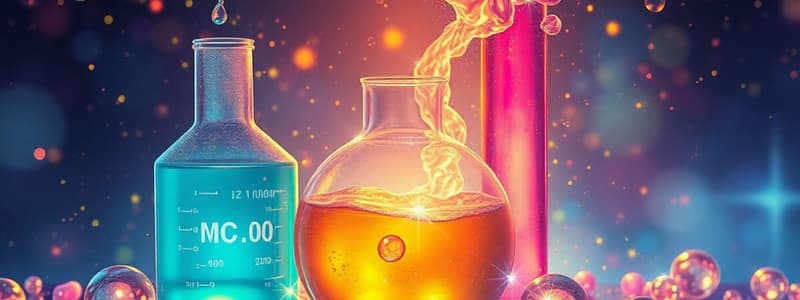Podcast
Questions and Answers
What is the definition of the concentration of a solution?
What is the definition of the concentration of a solution?
- The volume of solute divided by the volume of the solvent
- The total mass of the solution minus the mass of solute
- The amount of solute present in a given amount of solution (correct)
- The mass of solute divided by the volume of solvent
Which of the following is NOT a way to express the concentration of a solution?
Which of the following is NOT a way to express the concentration of a solution?
- Mass by volume percentage of solution
- Mass by mass percentage of solution
- Volume by volume percentage of solution
- Density of the solution (correct)
Which property distinguishes a suspension from a colloidal solution?
Which property distinguishes a suspension from a colloidal solution?
- Suspensions are stable even when disturbed
- Suspensions contain larger particles that settle when undisturbed (correct)
- Suspensions can scatter light similarly to colloids
- Suspensions cannot be filtered to separate particles
What happens to the solute particles in a colloidal solution when left undisturbed?
What happens to the solute particles in a colloidal solution when left undisturbed?
Which of the following statements about suspensions is true?
Which of the following statements about suspensions is true?
What principle primarily explains the visibility of a beam of light passing through a colloidal solution?
What principle primarily explains the visibility of a beam of light passing through a colloidal solution?
Which of the following best describes the nature of a physical change?
Which of the following best describes the nature of a physical change?
Which method is NOT effective for separating colloidal particles?
Which method is NOT effective for separating colloidal particles?
Flashcards
Concentration of a Solution
Concentration of a Solution
The amount of solute in a given amount of solution.
Mass by Mass Percentage
Mass by Mass Percentage
Mass of solute divided by mass of solution, multiplied by 100.
Suspension
Suspension
A heterogeneous mixture where solute particles don't dissolve and settle out.
Colloid
Colloid
Signup and view all the flashcards
Tyndall Effect
Tyndall Effect
Signup and view all the flashcards
Heterogeneous Mixture
Heterogeneous Mixture
Signup and view all the flashcards
Physical Changes
Physical Changes
Signup and view all the flashcards
Filtration
Filtration
Signup and view all the flashcards
Study Notes
Concentration of a Solution
- Concentration is the amount (mass or volume) of solute present in a given amount (mass or volume) of solution.
Ways to Express Concentration
- Mass by mass percentage: (Mass of solute / Mass of solution) x 100
- Mass by volume percentage: (Mass of solute / Volume of solution) x 100
- Volume by volume percentage: (Volume of solute / Volume of solution) x 100
Suspensions
- Suspensions are heterogeneous mixtures.
- Particles are large enough to be seen with the naked eye.
- Particles do not dissolve, but remain suspended throughout the mixture.
- Particles settle out when the mixture is undisturbed.
- Suspensions are unstable.
- Particles scatter light.
Colloidal Solutions
- Colloidal solutions are heterogeneous mixtures.
- Particles are too small to be seen with the naked eye, but are larger than true solutions.
- Particles do not settle out.
- Particles scatter light (Tyndall effect).
- Colloidal solutions are stable.
- Colloids cannot be separated by filtration, but can be separated using other techniques like centrifugation.
Physical and Chemical Changes
- Physical changes: Changes in a substance that do not change its chemical composition. These changes are often reversible (e.g., melting of ice).
- Chemical changes: Changes in a substance that result in the formation of new substances with different chemical compositions. These changes are usually irreversible (e.g., burning of a candle).
Studying That Suits You
Use AI to generate personalized quizzes and flashcards to suit your learning preferences.




